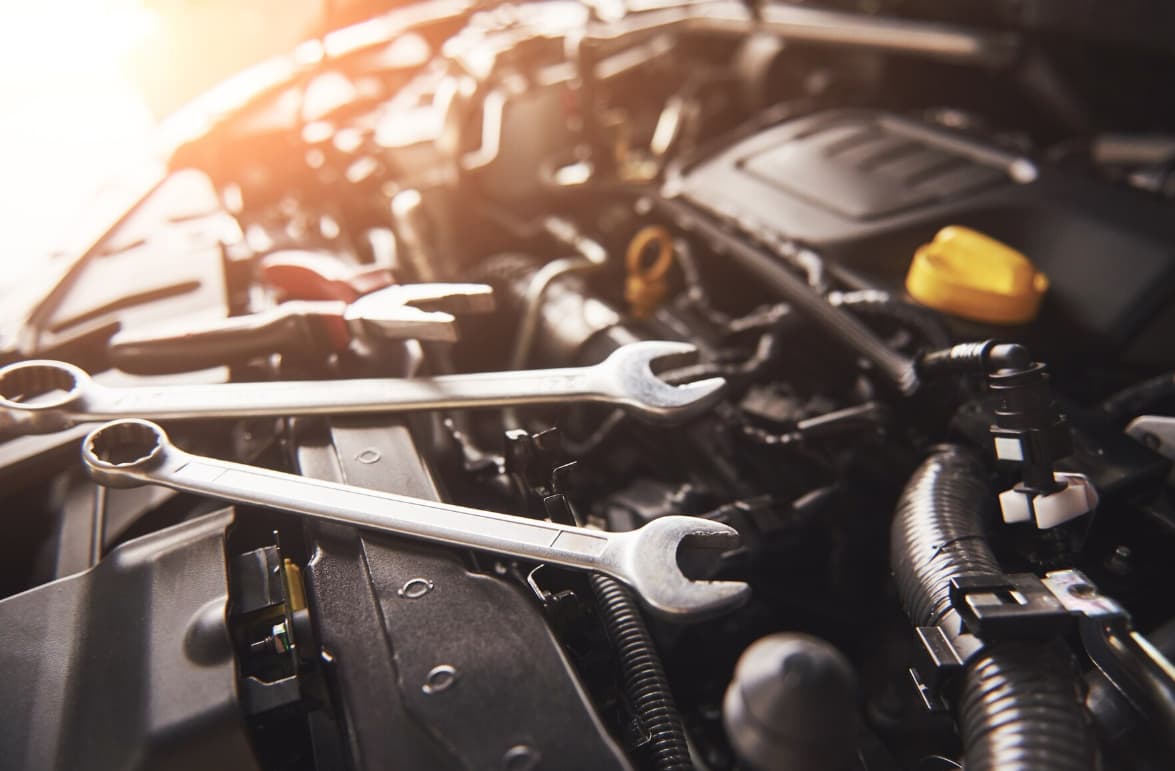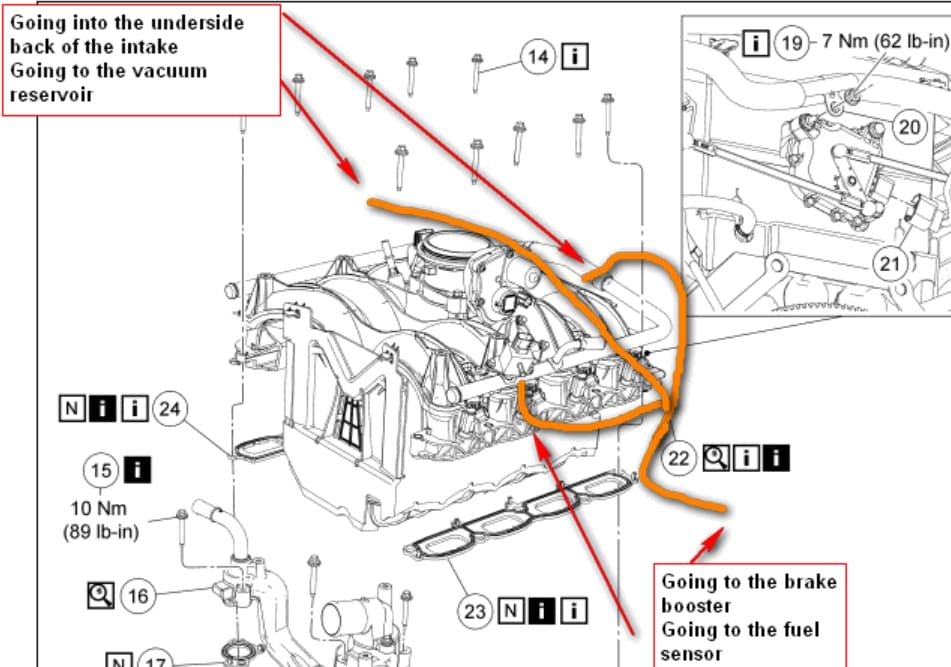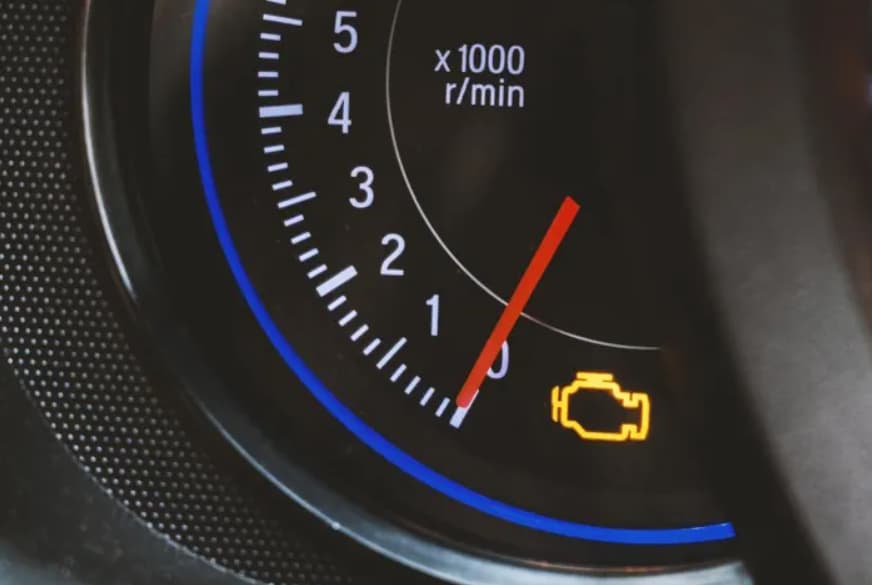When you pop the hood of your car, do you feel like you’re looking at a puzzle with a thousand pieces? You’re not alone.
For many people, the engine bay is a mysterious landscape filled with unfamiliar components. One such part that often leaves people scratching their heads is the vacuum hose.
In this comprehensive guide, we’re going to demystify the vacuum hose, with a special focus on its role in the Ford Triton 5.4 V8 engine.
We’ll explore what it is, where you can find it, why it’s crucial for your vehicle’s performance, and how to maintain it.
Whether you’re a car enthusiast looking to expand your knowledge or a Ford owner trying to understand your vehicle better, this guide is for you.
Ford Triton 5.4 Vacuum Hose Diagram

So, buckle up and get ready for a deep dive into the world of vacuum hoses!
Ford Triton 5.4 Vacuum Hose Diagram – Picture

What is the Ford Triton 5.4-liter V8 Engine?
Before we zoom in on the vacuum hose, let’s take a moment to appreciate the larger picture – the Ford Triton 5.4-liter V8 engine. This powerhouse is a key player in Ford’s “Modular” engine family, and it has quite a story to tell.
History and Development
The Triton 5.4-liter V8 made its debut in 1997, marking a significant milestone in Ford’s engine technology. Here’s a brief timeline of its journey:
- 1997: First introduced in Ford F-series trucks
- Late 1990s: Expanded to E-series vans
- 1997-2010: Used in F-series trucks
- 2010-Present: Continued use in E-series vans
Key Features
What makes the Triton 5.4 special? Let’s break it down:
- Modular Design: The term “modular” doesn’t refer to the engine’s construction but to the manufacturing process. Ford designed these engines so that the same production line could be quickly adapted to produce different engines in the family.
- Overhead Cam Design: Unlike older pushrod engines, the Triton uses overhead cams, which allow for better engine breathing and higher RPM operation.
- Versatility: This engine has been used in a wide range of vehicles, from workhorses like the F-150 to high-performance machines like the Ford GT.
- Multiple Variants: Over the years, Ford has produced several versions of the 5.4, including:
- 2-valve per cylinder
- 3-valve per cylinder
- 4-valve per cylinder (used in high-performance applications)
The Supercharged Beast
One of the most impressive variants of this engine was the supercharged version used in the Ford Shelby GT500 Mustang. This monster of an engine could produce:
- 550 horsepower
- 510 lb-ft of torque
To put that in perspective, that’s enough power to launch a car from 0 to 60 mph in just over 4 seconds!
What Do Vacuum Hoses Do?
Now that we understand the engine our vacuum hose calls home, let’s explore the role of these unassuming rubber tubes. Vacuum hoses have been an integral part of internal combustion engines since the late 1900s, and they continue to play a vital role in modern vehicles.
The Basics of Engine Vacuum
To understand vacuum hoses, we first need to grasp the concept of engine vacuum. When an engine is running, it’s essentially a big air pump. As the pistons move down, they create a low-pressure area in the cylinder. This low pressure, or vacuum, is what draws the air-fuel mixture into the engine.
But this vacuum isn’t just used for pulling in fuel. Clever engineers have found ways to harness this vacuum to power various systems in your vehicle.
Functions of Vacuum Hoses
Vacuum hoses act as conduits, channeling this engine vacuum to different components. Here’s a list of some key systems that rely on vacuum power:
- Brake Booster: This is perhaps the most critical function. The vacuum helps multiply the force you apply to the brake pedal, making it much easier to stop your vehicle.
- Power Steering: In some vehicles, vacuum assist helps make steering easier, especially at low speeds.
- Heating, Ventilation, and Air Conditioning (HVAC) Controls: Vacuum power often controls the flaps and valves in your car’s climate control system.
- Emissions Control Systems: Components like the EGR (Exhaust Gas Recirculation) valve use a vacuum for operation, helping to reduce harmful emissions.
- Cruise Control: In older vehicles, the cruise control system often relied on the vacuum to maintain a steady speed.
- Automatic Transmission: Some automatic transmissions use vacuum modulation to help determine when to shift gears.
- Door Locks: In some older vehicles, the central locking system was powered by an engine vacuum.
The Impact on Driving Experience
It’s not an exaggeration to say that vacuum hoses have revolutionized the driving experience. Here’s how:
- Easier Braking: Before vacuum-assisted brakes, stopping a car requires significant physical effort. Vacuum power makes braking effortless, improving safety.
- Smoother Steering: Vacuum-assisted power steering reduces the effort needed to turn the wheel, especially when parking or maneuvering at low speeds.
- Comfortable Climate Control: The precise control of airflow and temperature in modern cars owes much to vacuum-powered systems.
- Improved Fuel Efficiency and Reduced Emissions: Vacuum-operated emissions control systems help engines run cleaner and more efficiently.
What Does a Vacuum Hose Look Like?
Now that we understand the importance of vacuum hoses, let’s learn how to identify them in your Ford Triton 5.4 V8 engine.
General Appearance
A vacuum hose is typically:
- J-shaped: This distinctive shape allows it to connect different components efficiently.
- Made of rubber: This material is flexible enough to route around engine components and withstand engine heat.
- Black in color: Though this can vary, most vacuum hoses are black to resist degradation from oil and heat.
- About 1/4 inch in diameter: This can vary depending on the specific application.
Location in the Engine Bay
The exact location of the vacuum hose can vary depending on your vehicle’s transmission type. Let’s look at both scenarios:
Non-Overdrive Transmission
If your Ford truck or van has a non-overdrive transmission, here’s where to look:
- Open the hood and locate the right side of the engine bay.
- Look for a component that resembles a large nut – this is the vacuum manifold.
- You should see a J-shaped rubber hose connected to this manifold.
Overdrive Transmission
For vehicles with an overdrive transmission:
- Open the hood and look towards the center of the engine bay.
- Locate the area between the hose assembly and the vacuum reservoir.
- You should spot a J-shaped rubber hose in this area.
Identifying the Vacuum Manifold
The vacuum manifold is a crucial component in this system. It looks like an oversized nut and serves as a central hub for distributing vacuum to various systems. Multiple vacuum hoses may connect to this manifold, branching out to different parts of the engine and vehicle systems.
Can You Drive With a Broken or Leaking Vacuum Hose?
Now that we know what vacuum hoses do and where to find them, let’s address a critical question: Is it safe to drive if your vacuum hose is damaged?
The Short Answer: It’s Not Recommended
While your car might still run with a damaged vacuum hose, it’s not safe or advisable to drive in this condition. Here’s why:
Safety Concerns
- Brake Performance: A leak in the vacuum system can significantly reduce the effectiveness of your brake booster. This means you’ll need to apply much more force to the brake pedal to stop your vehicle. In an emergency situation, this could be dangerous.
- Steering Difficulty: If your power steering uses vacuum assist, a leak could make steering much harder, especially at low speeds or when parking.
- Unpredictable Behavior: Depending on which systems are affected, your car might behave erratically. For instance, the transmission might shift at odd times, or your cruise control might not work properly.
Performance Issues
Beyond safety, a broken vacuum hose can cause several performance problems:
- Rough Idle: You might notice your engine running roughly when idling.
- Poor Fuel Economy: A vacuum leak can disrupt the air-fuel mixture, leading to decreased fuel efficiency.
- Reduced Power: Your engine might feel less responsive or powerful.
- Check Engine Light: A vacuum leak often triggers the check engine light due to its effect on emissions systems.
Environmental Impact
A faulty vacuum hose can also lead to increased emissions, as it may prevent emissions control systems from functioning correctly.
What to Do If You Suspect a Vacuum Hose Problem?
If you notice any of these symptoms:
- Don’t Panic: While it’s not ideal, a vacuum hose problem usually won’t cause immediate catastrophic failure.
- Reduce Speed: If you’re on the road, slow down and be extra cautious with braking and steering.
- Find a Safe Spot: Look for a safe place to pull over and stop.
- Call for Help: It’s best to have your vehicle towed to a mechanic rather than risk driving with compromised systems.
Remember, it’s always better to be safe than sorry when it comes to your vehicle’s critical systems. A small inconvenience now can prevent a major accident later.
How to Identify a Damaged Vacuum Hose?
Catching a vacuum hose problem early can save you from dangerous driving conditions and costly repairs. Here’s how you can check your vacuum hoses for damage:
1. Visual Inspection
This is the easiest and often most effective method to spot issues. Here’s what to do:
- Open the Hood: Make sure your engine is cool before you start.
- Locate the Vacuum Hoses: Use the information from earlier sections to find the hoses.
- Look for Visible Damage: Check for:
- Cracks or splits in the rubber
- Bulges or weak spots
- Hardened or brittle sections
- Chafing or wear, especially where the hose touches other engine parts
- Loose connections or hoses that have come completely detached
- Check Connections: Make sure each end of the hose is securely attached to its respective component.
- Inspect Related Components: Look at the vacuum manifold and other connected parts for signs of damage or leaks.
What to Look For?
| Type of Damage | What It Looks Like | Possible Causes |
|---|---|---|
| Cracks | Small splits in the rubber | Age, heat exposure |
| Bulges | Swollen areas on the hose | Internal weakness, heat damage |
| Brittleness | Hose feels hard and inflexible | Age, oil contamination |
| Chafing | Worn spots, usually on bends | Rubbing against other components |
| Detachment | Hose is not connected properly | Loose clamp, previous improper repair |
2. Listen for Unusual Sounds
Sometimes, you can hear a vacuum leak:
- Start the Engine: With the hood open and the engine running, listen carefully.
- Hissing Sound: A vacuum leak often produces a distinct hissing noise.
- Locate the Sound: Try to pinpoint where the hissing is coming from.
Be cautious around a running engine and never touch moving parts!
3. Use a Vacuum Gauge
For a more precise diagnosis, you can use a vacuum gauge:
- Warm Up the Engine: Let it run until it reaches normal operating temperature.
- Connect the Gauge: Attach it to a vacuum port on the engine. This is usually on the intake manifold.
- Read the Gauge: At idle, most engines should show:
- 17 to 21 inches of mercury (in-Hg) at sea level
- Slightly lower readings at higher altitudes
- Interpret the Results:
- Steady low reading: Might indicate a vacuum leak
- Fluctuating needle: Could suggest valve problems
4. Smoke Test
This is a more advanced method usually done by professionals:
- A special machine pumps harmless smoke into the vacuum system.
- Leaks are revealed where the smoke escapes.
5. Soapy Water Method
This DIY method can help locate leaks:
- Mix dish soap with water to create a soapy solution.
- With the engine running, brush the solution onto suspected leak areas.
- Bubbles will form where there’s a leak.
When to Seek Professional Help?
If you’re not comfortable performing these checks, or if you’ve found damage but aren’t sure how to proceed, it’s best to consult a professional mechanic. They have the tools and expertise to accurately diagnose and fix vacuum hose issues.
Repairing Vacuum Hoses
Once you’ve identified a problem with your vacuum hose, the next step is to fix it. Here are your options:
1. Complete Replacement
This is often the best and safest option:
- Ensures the entire hose is in good condition
- Eliminates the risk of missed damage
- Often not much more expensive than partial repair
2. Partial Repair
For minor damage or as a temporary fix:
- Cut out the damaged section
- Use connectors to join the good parts
- Be careful not to shorten the hose too much
3. Professional Repair
For complex systems or if you’re unsure:
- A mechanic can ensure the repair is done correctly
- They can check for related issues you might have missed
Remember, a properly functioning vacuum system is crucial for your vehicle’s performance and safety. Don’t cut corners when it comes to repairs!
FAQs:
- Q: How often should I check my vacuum hoses?
A: It’s a good idea to visually inspect your vacuum hoses every 6 months or during your regular oil changes. However, if you notice any changes in your vehicle’s performance, especially in braking or steering, check them immediately.
- Q: Can I replace a vacuum hose myself?
A: If you’re comfortable working on your car and can identify which hose needs replacement, it’s possible to do it yourself. However, given the importance of these components, if you’re unsure, it’s best to consult a professional mechanic.
- Q: How much does it cost to replace a vacuum hose?
A: Costs can vary widely depending on the specific hose, your vehicle model, and labor rates in your area. Generally, you might expect to pay anywhere from $50 to $200. The hose itself is usually inexpensive, but labor costs can add up if the hose is in a hard-to-reach location.
- Q: What happens if my vacuum hose fails while I’m driving?
A: You might notice harder steering, less responsive brakes, rough idling, or decreased engine performance. If this happens, slow down safely, turn on your hazard lights, and stop as soon as it’s safe to do so. It’s best to have your car towed to a mechanic rather than risk driving with compromised systems.
- Q: Are all vacuum hoses the same?
A: No, vacuum hoses can vary in size, material, and design depending on their specific function and the vehicle model. Always use the correct type of hose for your specific Ford Triton 5.4 engine. Using the wrong hose could lead to poor performance or even damage to your engine.
- Q: Can extreme weather affect my vacuum hoses?
A: Yes, weather can have a significant impact on vacuum hoses:
- Extreme heat can cause the rubber to degrade faster, leading to cracks or brittleness.
- Severe cold can make the hoses less flexible, potentially leading to cracks if they’re moved while very cold.
- High humidity environments might encourage mold growth inside the hoses over time.
Regular inspections are especially important if you live in an area with extreme weather conditions.
- Q: How long do vacuum hoses typically last?
A: With proper care, vacuum hoses can last anywhere from 50,000 to 100,000 miles. However, this can vary greatly depending on driving conditions, climate, and the quality of the hoses. Some signs that it’s time to replace your hoses include:
- Cracks or splits in the rubber
- A spongy or soft texture
- Visible swelling or bubbles
- Hoses that feel brittle or inflexible
- Q: Can a damaged vacuum hose affect my fuel efficiency?
A: Yes, a leaking vacuum hose can impact your fuel efficiency. Here’s why:
- It can cause an air leak in the intake system, disrupting the ideal air-fuel ratio.
- This can make the engine run “rich” (too much fuel compared to air), wasting fuel.
- The engine might have to work harder to compensate for the leak, using more fuel in the process.
If you notice a sudden drop in fuel efficiency, checking your vacuum hoses is a good place to start.
- Q: Are there any preventive measures I can take to extend the life of my vacuum hoses?
A: Absolutely! Here are some tips:
- Regular Inspections: Check your hoses visually every 6 months.
- Keep Engine Clean: A clean engine bay reduces the risk of oil and grime degrading the hoses.
- Avoid Excessive Heat: If possible, don’t park in direct sunlight for extended periods.
- Address Issues Promptly: If you notice any problems, get them fixed quickly to prevent further damage.
- Use Quality Parts: When replacing hoses, opt for high-quality ones designed for your specific engine.
- Q: Can I use silicone vacuum hoses instead of rubber ones?
A: Silicone hoses can be a good upgrade from standard rubber hoses. They offer several advantages:
- More resistant to heat and cold
- Longer lifespan
- Less prone to cracking and degradation
However, they are typically more expensive. If you decide to switch to silicone hoses, make sure they’re the correct size and are rated for use in automotive vacuum systems.
- Q: How do vacuum hoses relate to my car’s emissions system?
A: Vacuum hoses play a crucial role in your car’s emissions system:
- They help control the EGR (Exhaust Gas Recirculation) valve, which reduces nitrogen oxide emissions.
- They assist in the operation of the EVAP (Evaporative Emission Control) system, which prevents fuel vapors from escaping into the atmosphere.
- A leak in the vacuum system can throw off the air-fuel ratio, potentially increasing harmful emissions.
This is why a damaged vacuum hose can sometimes trigger the check engine light.
- Q: Can I use tape to fix a leaking vacuum hose temporarily?
A: While it might be tempting to use tape as a quick fix, it’s not recommended. Here’s why:
- Tape isn’t designed to withstand the heat and pressure in an engine bay.
- It won’t provide a proper seal, allowing the leak to continue.
- It could come loose while driving, potentially causing more damage.
Instead, if you need a temporary fix to get to a mechanic, consider using a rubber splice and hose clamps. But remember, this should only be a short-term solution until you can properly replace the hose.
- Q: How do I know if a problem is caused by a vacuum hose issue or something else?
A: It can be tricky to pinpoint vacuum hose issues because the symptoms can be similar to other problems. Here’s a quick guide:
| Symptom | Possible Vacuum Hose Issue | Other Potential Causes |
|---|---|---|
| Rough idle | Yes | Spark plugs, fuel injectors |
| Hard braking | Yes | Brake pads, brake fluid leak |
| Stiff steering | Yes | Power steering fluid, steering rack |
| Check engine light | Yes | Numerous engine issues |
| Poor fuel economy | Yes | Oxygen sensors, fuel injectors |
If you’re experiencing any of these symptoms, it’s best to have a professional diagnose the problem. They can perform specific tests to determine if the vacuum system is the culprit.
Maintaining Your Ford Triton 5.4 Vacuum System
To wrap up our comprehensive guide, let’s discuss some best practices for maintaining the vacuum system in your Ford Triton 5.4 engine:
- Regular Inspections: Make checking your vacuum hoses part of your routine maintenance. Every time you change your oil, take a few minutes to visually inspect the hoses.
- Listen to Your Engine: Become familiar with how your engine normally sounds. A change in engine noise, especially a hissing sound, could indicate a vacuum leak.
- Keep It Clean: Regularly clean your engine bay. This not only makes it easier to spot issues but also helps prevent oil and grime from degrading your hoses.
- Address Issues Promptly: If you suspect a vacuum hose problem, don’t put off getting it checked. Small issues can quickly become big (and expensive) problems if left unaddressed.
- Use Quality Parts: When it’s time to replace hoses, invest in high-quality parts. The few extra dollars you spend now could save you much more in the long run.
- Consider Upgrades: If you frequently drive in extreme conditions, consider upgrading to silicone hoses for better durability.
- Keep Records: Maintain a log of when you inspect and replace vacuum hoses. This can help you stay on top of maintenance and spot any recurring issues.
By following these guidelines and staying attentive to your vehicle’s performance, you can ensure that your Ford Triton 5.4’s vacuum system remains in top condition, contributing to the overall health and longevity of your engine.
Also Check: Ford F150 Theft Light Blinking Won’t Start
Conclusion:
The vacuum hose might seem like a small and insignificant part of your Ford Triton 5.4 V8 engine, but as we’ve seen, it plays a crucial role in various vehicle systems.
From assisting with braking and steering to helping control emissions, these humble rubber tubes are truly unsung heroes in your engine bay.
Key takeaways:
- Location Matters: In the Ford Triton 5.4, the vacuum hose location depends on your transmission type. Always refer to your vehicle’s manual for the most accurate information.
- Regular Checks are Important: Make it a habit to visually inspect your vacuum hoses during routine maintenance. Catching problems early can prevent more serious issues down the road.
- Safety First: If you suspect a vacuum hose problem, it’s best not to drive the vehicle until it’s been checked by a professional. The risk to crucial systems like braking and steering is not worth taking.
- DIY with Caution: While some vacuum hose issues can be diagnosed and even repaired at home, don’t hesitate to seek professional help if you’re unsure. Your safety is paramount.
- Prevention is Key: Regular maintenance and careful driving can help extend the life of your vacuum hoses and other engine components.
Understanding your vehicle’s components, including seemingly minor parts like vacuum hoses, empowers you to take better care of your car and make informed decisions about its maintenance.
While the world under your hood might seem complex, every part, no matter how small, plays a role in keeping you safely on the road.
Remember, a little knowledge goes a long way in car ownership. Now, when you lift that hood, you’ll be able to spot and understand the importance of those J-shaped rubber tubes.
That’s one more mystery solved in the complex world of automotive engineering!



